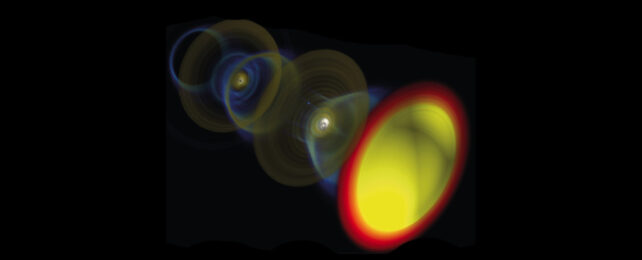To pry into the private lives of objects in the microscopic domain (and beyond), scientists often rely on extremely bright sources of light.
The free electron lasers that get the best results accelerate electrons over several kilometers towards light speed, wiggling them through a large hall of magnets to shake free intense pulses of photons that light up materials for study.
Now, an international team of physicists think they can achieve the same effect with a much smaller device using quasiparticles – particle-like entities that emerge out of the complex interactions of a collective of other particles.
If their concept can be developed into a workable technology, it may give even more researchers around the world unparalleled visibility into the tiniest structures they are studying, yielding insights into viruses, computer chips, photosynthesis, and the chemistry of the stars.
Particle accelerators that can fit inside a building are much less powerful than those like the Linac Coherent Light Source (LCLS) in California. The size of a small town, its lengthy electron racetrack is capable of emitting highly energetic waves of light in the X-ray part of the spectrum.
But there has been progress made towards miniaturizing particle accelerators, particularly when it comes to devices that accelerate charged particles or plasma.
A team of international researchers used computer simulations to demonstrate how these compact plasma accelerators could produce bright light equivalent to that created by large particle accelerators.
The trick was understanding how the plasma accelerators generate quasiparticles.
Quasiparticles are coherent systems that can emerge when mediums are disturbed or excited. Though formed as a group effort, they can be treated like discrete particles as they have stable properties, like charge, mass, energy, size, shape, and momentum.
Because quasiparticles can be created through the coordinated motion of a collection of light-emitting particles moving through a medium, they can slip through loopholes in the laws of physics that would otherwise constrain more ordinary particles.
They can even travel faster than light would travel in the same medium. This is possible because light slows down when traveling through anything other than a vacuum, so quasiparticles can overtake it.
"The most fascinating aspect of quasiparticles is their ability to move in ways that would be disallowed by the laws of physics governing individual particles," says physicist and co-author John Palastro.
"The flexibility is enormous," says doctoral student and first author Bernardo Malaca.
"Even though each electron is performing relatively simple movements, the total radiation from all the electrons can mimic that of a particle moving faster than light or an oscillating particle, even though there isn't a single electron locally that's faster than light or an oscillating electron."
Quasiparticles can also create superradiance; an ultra-bright beam of photons that is produced by a collection of particles working in sync.
The researchers showed that it would be theoretically possible to create this superradiance using quasiparticles inside a plasma laser, creating wavelengths between infrared and ultra violet parts of the spectrum.
"Such an advance could bring research and technology that is only available in a handful of free electron lasers worldwide directly to the many university, hospital, and industrial scale laboratories," the researchers wrote.
"Hence, the onset of temporal coherence and superradiance is the essential missing ingredient to create compact, affordable, and competitive plasma accelerator-based light sources."
This paper was published in Nature Photonics.
